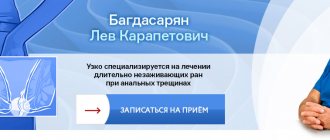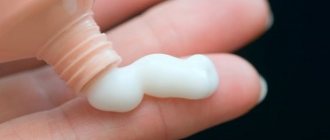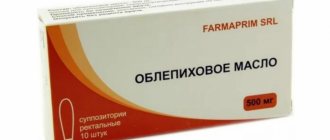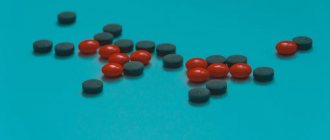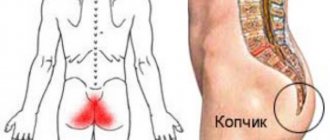Attention!
The information in the article is for reference only and cannot be used for self-diagnosis or self-medication. If you notice any symptoms of the disease, contact your doctor.
- Suppositories for hemorrhoids
- Ointment for hemorrhoids
- Tablets for hemorrhoids
- Surgery to remove hemorrhoids
Hemorrhoids are varicose veins of the rectum and anus. Dilated veins are deformed with the formation of hemorrhoids, their walls become thinner and become easily vulnerable. Hemorrhoids can be either an independent disease or a manifestation of another pathology, for example, cirrhosis of the liver.
Types of hemorrhoids
There are three types of pathology - external, internal and mixed hemorrhoids.
Interior
Internal hemorrhoids are considered to be the presence of varicose veins inside the ampulla. Nodes are formed inside on its walls. The formations lie in the thickness of the mucous ampulla of the rectum, located above the dentate zone. Here is the internal venous plexus.
The inner ties are quite treacherous. They do not show themselves in anything for a long time. Small lumps remain asymptomatically inside the intestine for a long time. Only later, when the process decompensates, do clinical manifestations become obvious - discomfort, burning in the anal area, swelling in this area, painful bowel movements, blood on toilet paper.
Outer
External hemorrhoids are a pathology that forms when blood circulation in the anal venous network is impaired. Vasodilation occurs in certain areas of the vessels - cavernous bodies, followed by the formation of nodes. They are located directly under the skin in the area below the rectal-anal line.
There are common and complicated forms of the disease. With it, hemorrhoids bleed, fall out, become pinched and ulcerate. This type of damage to the venous vessels in the anal area manifests itself with striking clinical manifestations. External hemorrhoids almost immediately after their appearance introduce discomfort into the patient’s usual lifestyle.
The patient is concerned about pain in the anal area and itching. They appear first during bowel movement, and then are present constantly. Symptoms intensify with physical activity, sneezing, and sitting for long periods of time.
The appearance of inflammation
The appearance of inflammation is accompanied by swelling of the node, but this does not always happen. In some cases, this happens when nodes become pinched or fall out, which can be accompanied by copious amounts of blood. In this condition, complex therapy is carried out.
Inflammation creates persistent discomfort in the patient, which is expressed in the inability to sit for long periods of time, the appearance of sharp and severe pain when coughing, sneezing and any manifestation of tension.
Important note. Typically, the signs of external hemorrhoids located outside the intestine resemble the signs of internal hemorrhoids located inside the intestine. The main difference is that the development of the disease and the appearance of symptoms occurs outside the intestine and inside, respectively.
Hemorrhoids in women
Contrary to popular belief that men are more likely to suffer from hemorrhoids, they often occur in women as well. Predisposition to the disease is inherited, and its occurrence is also determined by the patient’s lifestyle. In patients it often occurs for the following reasons:
- constipation;
- passive lifestyle;
- pregnancy;
- as a complication during childbirth;
- due to vascular pathologies.
Hemorrhoids in women occur due to pathologies in the pelvic cavity, digestive disorders and tumors.
Prices
Price (rub.)In installments* (rub.)Consultation with a surgeon on the operation (SPECIAL)0—Online doctor’s opinion on the operation (SPECIAL)0—Hemorrhoidectomy Cat. I. complexity from 20,000—Non-surgical removal of hemorrhoids, category I. complexity from 3550—Coagulation of a hemorrhoid using radio wave surgery from 6400—Thrombosis of hemorrhoids (1 ligation) from 300—Thrombectomy from an external hemorrhoid from 4800—Removal of a thrombosed hemorrhoid I cat. complexityfrom 7800—Removal of a thrombosed hemorrhoid, category II. complexity from 9600—Removal of a thrombosed hemorrhoid, category III. complexityfrom 13750—See full list
Hide
* You can read more about the conditions here - Treatment on credit or in installments
The cost is preliminary. The exact cost of the operation can only be determined by a surgeon during a free consultation.
Hemorrhoids in men
Hemorrhoids occur slightly more often in men than in women. The reason for this is the lack of attention on the part of the stronger sex to their health. They see a doctor in the later stages of the disease. The causes of hemorrhoids in men are as follows:
- work with a predominance of heavy physical labor, heavy lifting;
- sedentary work;
- presence of bad habits: alcohol abuse, smoking;
- nutritional obesity;
- neglecting the need to regularly empty the intestines;
- prolongation of the act of defecation;
- chronic stress.
The causes of secondary hemorrhoids are somatic diseases: oncological processes, portal hypertension, heart failure.
Stages of hemorrhoids
Hemorrhoids go through several stages in their development. They are characterized by the following manifestations:
- First. At this stage, moderate bleeding from hemorrhoids in the anus is detected. The patient notices it after defecation on toilet paper. At other times there is practically no bleeding. Sometimes bowel movements are accompanied by shooting pain. In the external form, a small formation appears located at the anus. It's painful. With the internal version of the disease, minor bleeding is observed.
- Second. At this degree, a more pronounced clinical picture appears with a characteristic symptomatic complex. The venous nodes are already protruding, but they are also retracted into the rectum on their own. This process is accompanied by a slight release of blood. Among the typical clinical manifestations, prolapse of hemorrhoids is noted. Blood is released after defecation or at rest. There is mucus discharge from the anus, burning, peeling around the anus and itching. Nodes may fall out. This occurs after significant physical activity, with constipation and sudden movements.
- Third. At this stage, nodes fall out. They can no longer retract on their own. To reduce the formations, a special procedure must be performed. You can perform manual reduction yourself. When the prolapse occurs, bleeding begins. It occurs after intense physical exertion. The patient has bleeding both at rest and after bowel movement. He experiences itching and flaking of the skin near the anus. Often the situation is complicated by the formation of anal fissures, wounds, and sphincter incontinence. The patient experiences constant discomfort, as well as paroxysmal shooting pains. Mucus mixed with blood is often released from the anus. A small amount of it indicates thinning of the walls of the node. A large amount of blood indicates that the blood clot has spread beyond the node.
- Fourth. This stage significantly reduces the quality of life. The nodes fall out and cannot be adjusted either manually or using special procedures for reduction. The patient constantly leaks blood from the nodes. Bleeding increases after defecation. The patient experiences discomfort due to rectal sphincter incontinence. The patient periodically experiences acute pain. Numerous wounds and cracks around the anus are revealed. He constantly scratches this area, and a secondary infection develops. Formed blood clots can break off at any time and block blood flow through the pelvic vessels.
The patient’s treatment tactics depend on the identified stage of hemorrhoids. In the initial stages of the disease, conservative therapy is used. In the later stages of the inflammatory process, surgical techniques are used for treatment.
How to determine external and internal hemorrhoids
Normal hemorrhoidal tissue is not visible because it must first swell and become inflamed or form a clot to cause symptoms. Swollen external hemorrhoids or internal prolapsed hemorrhoids outside the anus may be seen, but internal hemorrhoids are not visible because the nodes remain inside the anus. A thrombosed hemorrhoid will appear as a lump on the edge of the anus protruding from the anus and will be dark bluish in color due to the clot contained within the swollen blood vessel. A nonthrombosed hemorrhoid will appear as a lump of skin. Often several swollen hemorrhoids appear at the same time.
Diagnosis of hemorrhoids
Diagnosis of this disease is not difficult. It is performed by a proctologist or surgeon. The doctor interviews the patient, finds out his complaints and information about the course of the disease. Then carries out the following activities:
- Inspection. They examine patients in a chair. To do this, bring your knees as close to your stomach as possible. If there is no chair, the examination is carried out in the knee-elbow position. The doctor examines the anus area. Reveals his anal deformation. He evaluates the skin around it and examines the hemorrhoids.
- Finger examination. The condition of the external and internal sphincters, as well as the mucous membrane, is studied. The doctor determines the location and size of hemorrhoids. He evaluates the possibility of their reduction.
- Anoscopy. This endoscopic method allows you to examine up to 12 cm of the anal canal. Patients easily tolerate this procedure. With its help, the location of internal nodes is determined.
- Sigmoidoscopy. It is prescribed to exclude pathology of the upper intestines.
If it is necessary to identify complications and concomitant pathologies, the patient is referred to other types of examination - ultrasound of the abdominal cavity and gastroscopy.
What triggers the development of hemorrhoids
The disease is based on two reasons:
- pathology of the vascular apparatus in the anus;
- weakness of the muscles of the rectum and rectal sphincter.
The veins in the submucosal and subcutaneous layer of the anorectal zone form cavernous bodies, which, when tone is lost, cannot cope with the load, become overfilled with blood and stretch with the formation of “bumps”. If left untreated, the muscle walls weaken and the overgrown nodes begin to fall out.
The list of provoking factors is the main difference in the formation of hemorrhoids in different sexes. If for women the main role is played by menstruation, pregnancy, childbirth, then for men it all comes down to an incorrect lifestyle. The main “male” factors in the development of the disease:
- sedentary, sedentary work - the outflow and inflow of blood is disrupted;
- unbalanced diet and chronic constipation developing against their background - fried, smoked, canned, spicy foods disrupt digestion;
- physical activity with weight lifting, strength sports;
- abuse of bad habits - alcohol, smoking;
- constant nervous stress;
- inflammatory processes in the prostate gland or bladder can cause venous stagnation;
- physical malformations - for example, lack of valves in the hemorrhoidal veins.
The situation is aggravated by hereditary predisposition and the presence of chronic diseases of the digestive system.
Attention! Successful treatment of hemorrhoids is possible only after complete elimination of the provoking factors.
Treatment of hemorrhoids
Treatment of this pathology is determined by the stage of the disease, the presence of complications and the general condition of the patient.
Suppositories for hemorrhoids
Suppositories are quite effective in treating the initial stage of internal hemorrhoids. They are used as the main method of therapy. They have the following advantages:
- the drug is applied topically to damaged vessels and tissues, and is not absorbed into the general bloodstream;
- quickly remove pathological manifestations;
- no side effects;
- they are convenient to use;
- they have a minimum of contraindications.
In the later stages of the process, rectal suppositories are used as concomitant therapy for rehabilitation and follow-up treatment. Suppositories for hemorrhoids are divided according to the effect they have on the body:
- Painkillers. Pain relievers are present in suppositories for hemorrhoids.
- Anti-inflammatory. These drugs are used when there is inflammation in the nodes and nearby tissues. They reduce the activity of the rectal mucosa and in dilated veins.
- Anticoagulants. Medicines containing these substances reduce blood clots. They stop the coagulation of venous blood.
- Hemostatic. For bleeding from nodes, suppositories with hemostatic agents are used.
- Immunomodulators. They normalize local immunity and increase tissue resistance to infection.
Their action is aimed at relieving exacerbations and slowing down the progression of hemorrhoids.
Ointment for hemorrhoids
The drugs are used for external and internal hemorrhoids. The package contains special nozzles for administering the medicine into the rectum. They contain the following substances:
- anticoagulants;
- venotonics;
- hemostatics;
- anti-inflammatory;
- immunomodulators;
- hormonal;
- astringents;
- antiseptics.
Ointments are used in the early stages of nodule formation. They remove the main symptoms that bother the patient at this stage - irritation of the skin and mucous membranes, itching and burning.
Tablets for hemorrhoids
For the treatment of the disease, the main tablet drugs are considered to be drugs from the group of venotonics and angioprotectors. They strengthen the vascular wall, prevent the progression of hemorrhoids, and increase the tone of the veins. For persistent severe pain, patients are prescribed painkillers.
Surgery to remove hemorrhoids
To excise hemorrhoids, classical and minimally invasive surgical techniques are now used in surgery. They are carried out at the third and fourth stages of the pathological process. The following minimally invasive interventions are used:
- disarterization - ligation of the arteries supplying the node;
- latex ligation - excludes hemorrhoidal formation from the bloodstream by placing a latex ring on its base;
- sclerotherapy - a special preparation is injected into the node, gluing its walls;
- laser coagulation – the laser coagulates the entire venous formation;
- cryodestruction - the node is frozen with liquid nitrogen.
Classic surgery is now used only if a minor intervention does not achieve the desired result.
Itching and burning
Itching and burning may occur in the following cases:
- Skin irritation if mucus appears near the anus. May appear due to anal fissures.
- Healing of cracks. With a temporary lull in the disease and its transition to a latent phase, healing of cracks occurs, which causes itching and burning.
- An allergic skin reaction caused by medicinal suppositories. If suppositories administered for the treatment of hemorrhoids contain substances that can provoke an allergic reaction.
Important note. Burning and itching in women are also caused by thrush. These are different diseases and their treatment is different.
You should take discomfort in the anus seriously. This may be a symptom of hemorrhoids. We must not forget that it is always easier to cure a disease at an early stage. There is no need to lead to undesirable consequences that could lead to surgery.
The reason to visit a doctor should be the first signs, not severe consequences. Modern diagnostics will allow us to detect the presence of the disease, its phase and determine treatment methods.



